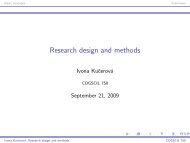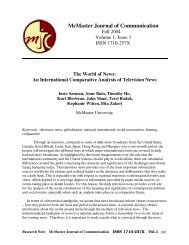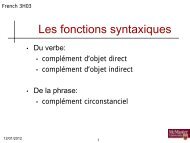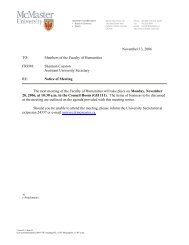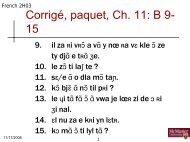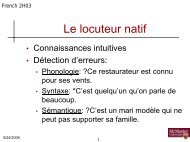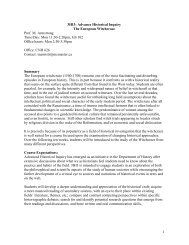The Syntax of Givenness Ivona Kucerová
The Syntax of Givenness Ivona Kucerová
The Syntax of Givenness Ivona Kucerová
You also want an ePaper? Increase the reach of your titles
YUMPU automatically turns print PDFs into web optimized ePapers that Google loves.
(19) a. What happened?<br />
b. Přijel vlak.<br />
arrived train<br />
‘A train arrived.’<br />
(20) a. What happened to the train?<br />
b. Vlak || přijel.<br />
train arrived<br />
‘<strong>The</strong> train arrived.’<br />
This is basically the story. 14 <strong>The</strong>re are still many questions that need to be addressed –<br />
and I will address them in the coming sections and chapters – but the core <strong>of</strong> the argument<br />
is as simple as this: If a given element α G is asymmetrically c-commanded by a non-G<br />
element, α G needs to move. If there is no <strong>of</strong>fending c-command relation, G-movement<br />
does not take place.<br />
Before I approach developing the syntactic system in more detail, I want to shortly address<br />
what I mean by given.<br />
In the literature on information structure it is agreed, at least since Halliday (1967), that<br />
an utterance may be divided into two parts, one <strong>of</strong> which is more established in the discourse<br />
(common ground, context. . . ) than the other. While the terminology and the actual<br />
approaches vary widely (see for example Kruijff-Korbayová and Steedman (2003) for a<br />
recent overview), there is a strong intuition that the two parts are complementary to each<br />
other. Thus, it is a reasonable assumption that a grammar might refer only to one <strong>of</strong> the<br />
parts. <strong>The</strong> question then is which part is relevant.<br />
<strong>The</strong> approach I take here is based on the idea that the part encoded in the grammar is<br />
the given part (on given/new or given/focus scale). For arguments for this type <strong>of</strong> approach<br />
see, for instance, Williams (1997); Schwarzschild (1999); Krifka (2001); Sauerland (2005);<br />
Reinhart (2006).<br />
As to the question <strong>of</strong> how exactly given is defined for now I will adopt Schwarzschild’s<br />
definition <strong>of</strong> givenness, stated in (21). <strong>The</strong> definition is based on the observation that<br />
for element α to be given, which in English roughly corresponds to being deaccented, α<br />
must be entailed by the previous discourse and α must have a salient antecedent. Since<br />
entailment refers to proposition, the definition ensures that entailment can be stated for any<br />
α (not only propositional but also referential and predicational), (21-b).<br />
(21) Definition <strong>of</strong> Given (modified from Schwarzschild 1999, p. 151, (25))<br />
α is interpreted as Given in an utterance U iff there is a salient antecedent A such<br />
that<br />
a. α and A corefer; or<br />
14 <strong>The</strong>re is one crucial piece missing: dependence <strong>of</strong> G-movement on head movement. I will discuss this<br />
property in section 1.3 and 2.3.<br />
16





